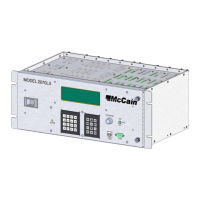2070LX Controller – User Manual 13
Version 1.0
Drivers:
The single ended signals coming from the Engine Board through the P1/P2 connectors enter to the line
drivers to be converted into differential signals and then routed to the A5 connector on serial
motherboard.
Four quadruple differential line drivers SN65LBC174A are used to transmit the communication differential
signals of SP-1, SP-2, SP-3, SP-4, SP-5 and SP-6 ports.
SP-1 and SP-2 transmission is enabled by the line A2_INSTALL; when this line is LOW the drivers are
disabled, when HIGH the drivers are enabled.
SP-3 transmission is permanently enabled (enable input is tied to +5VDC) on the drivers.
SP-5 transmission is enabled by the line A3_INSTALL; when this line is LOW the drivers are disabled,
when HIGH the drivers are enabled.
SP-4 and SP-6 transmission is permanently enabled on the drivers (enable inputs are tied to +5VDC).
Transmission signals:
SP-1: TxD+, TxD-, TxCLKO+, TxCLKO-, RTS+, RTS-.
SP-2: TxD+, TxD-, TxCLKO+, TxCLKO-, RTS+, RTS-.
SP-3: TxD+, TxD-, TxCLKO+, TxCLKO-, RTS+, RTS-.
SP-4: TxD+, TxD-.
SP-5: TxD+, TxD-, TxCLK+, TxCLK-.
SP-6: TxD+, TxD-.
2.4.1.6 Back up circuitry
This circuit provides a proper backup power source to the Engine Board in order to keep the required
functions working properly, i.e.: RTC and SRAM data.
It consists of a 2.2F 5VDC super capacitor, two common cathode dual diodes and a 150 ohm series
resistor.
This circuit is fed by the on-board +5VDC and the +5VDC standby from Power Supply, theses voltages
feed the super capacitor through a common cathode dual diode and a current limiting series resistor, the
super capacitor then delivers the standby voltage to the Engine Board through the other common cathode
dual diode.
2.4.1.7 Ethernet switches
The Host Board provides two, Layer 2, managed switches with auto-switching capability for both
10BASE-T and 100BASE-T systems.

